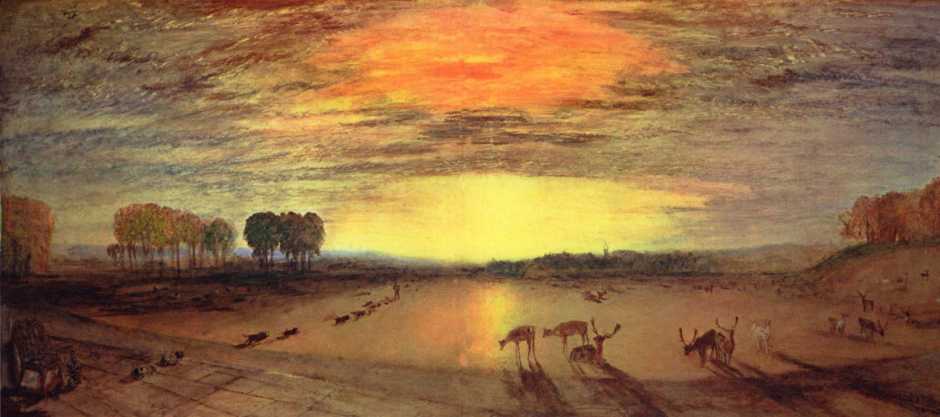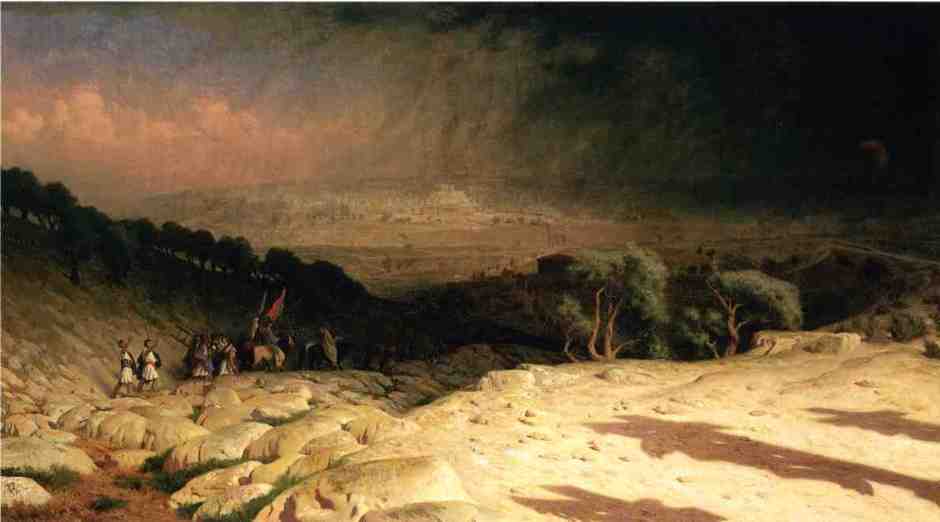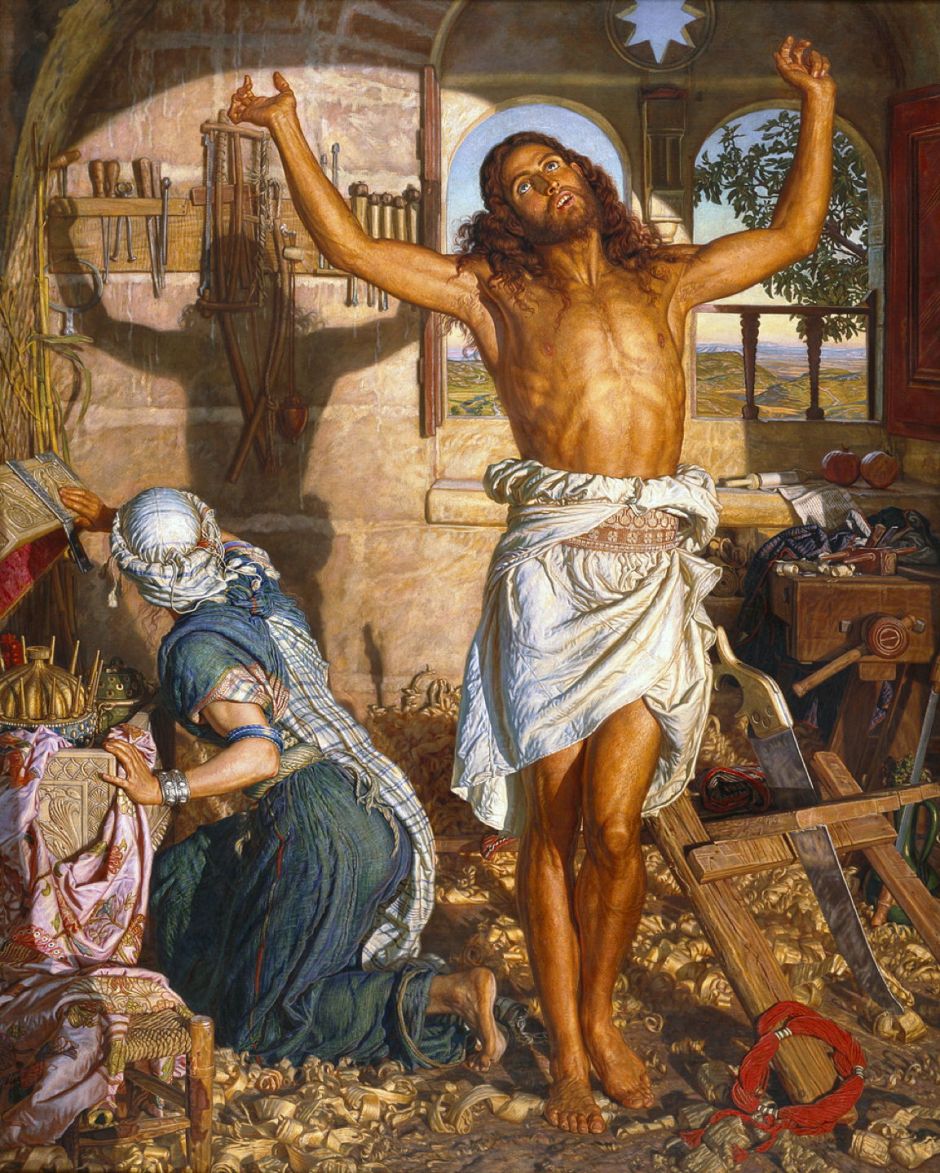According to ancient legend, the person who ‘invented’ painting was not a man, and did so by tracing the shadow of her boyfriend.
Dibutades, a maid of Corinth in Greece, was about to see her boyfriend sent away from the city on military service. As the daughter of a potter, she devised an ingenious way of making a portrait to remember him by: when he was asleep, she positioned a light to cast his shadow against a wall behind him, then she traced the outline of that shadow in the plaster. Once he had gone, her father then transformed his painted silhouette into the first relief sculpture by daubing clay within the silhouette.

In 1778, William Hayley told this story succinctly in his poem An Essay on Painting:
The line she trac’d with fond precision true,
And, drawing, doated on the form she drew …
Thus from the power, inspiring LOVE, we trace
The modell’d image, and the pencil’d face!
Hayley’s friend, the painter Joseph Wright of Derby, turned that into this painting of The Corinthian Maid in about 1782-5, as a commission for Josiah Wedgewood, the affluent founder of the local Wedgewood pottery.
Although I don’t believe a word of this legend, it serves to point out the importance of shadows in visual art, something which isn’t always appreciated by the viewer. Over the centuries, different types of shadow have been classified and named; here, for the sake of simplicity, I will consider just two broad classes: simple shadows resulting from an object’s three-dimensional form which fall on itself, and cast shadows, which are the shadows of objects which fall elsewhere.
Shadows of both types were shown in paintings long before the Renaissance, but it wasn’t until the drive towards vivid realism in the early Renaissance that careful attention was paid to shadows of various types.

Masaccio and Masolino were among those who progressed the accurate depiction of shadows in their paintings. In this example by Masolino, shadows cast by the different figures are still exploratory, and not optically consistent. The cripple at the left has the light on his back, and his cast shadow is projected directly in from of him. Other figures cast shadows which align more to the right, though. These probably arise because of the artist’s desire to project the shadows within the painting’s single-point 3D projection.

Antonello da Messina’s magnificent Saint Jerome in his Study from about 1475 shows well how the depiction of shadows progressed, in his skilful handling of multiple light sources. The two birds at the foot of the trompe l’oeil framing doorway are consistent with slightly diffuse light cast from behind the left of the viewer, which also illuminates the saint at his desk. Secondary sources come through the two windows which reveal miniature landscape views.

Shadows falling on the same object are classical examples of very strong cues to the shape and depth of the object, and became detailed in all good accounts of both drawing and painting. They are often the only features which enable the brain to transform an area of colour into a proper 3D object.
Paint the stem of a tree with uniform lightness and chroma and it will inevitably appear to be a flat surface; put even the simplest highlights and shadows in and it will immediately be perceived as being cylindrical in form. This is shown well in Moroni’s Portrait of a Gentleman with his Helmet on a Column Shaft from about 1555-6.

In the Northern Renaissance in particular, simple and cast shadows were used to transform grisaille paintings into trompe l’oeil mimicking sculptures. This example by Robert Campin is startlingly realistic.

Viewers, particularly those who don’t themselves paint, aren’t always good at noticing shadows in paintings. We are so used to seeing the world in relatively flat, even illumination that an absence of shadows doesn’t normally cause alarm. But when they are included, simple and cast shadows make a great difference, particularly in views dominated by buidings, as shown in Gerrit Adriaensz Berckheyde’s Groote Market in Haarlem, Amsterdam of 1673.

In figurative painting, painstaking attention to shadows is often central to success. This is best seen in works using chiaroscuro lighting, in which most of the canvas is very dark, and only limited details are lit, often using point sources of light.
Three Persons Viewing the Gladiator by Candlelight (1765) was Joseph Wright of Derby’s first exhibited painting, and a brilliant demonstration of his skill in making an image from the limited cues provided by well-lit fragments of figures and their simple shadows. In Wright’s case, this reflected the influence of the philosopher John Locke’s metaphor of the mind as a darkened room into which the eye lets in images to be reflected upon and stored.

JMW Turner used cast shadows in many of his landscapes, particularly those at sunrise or sunset, when their very long cast shadows emphasise the time of day. Petworth Park: Tillington Church in the Distance (c 1828), is viewed from a high level to further exaggerate the length of its shadows.
Cast shadows have long been used in ‘shadow play’, in which hands and other parts are used to create silhouettes of rabbits and other objects.

Johann Eleazar Zeissig shows this in A Family Making Chinese Shadows, which was painted in the late 1700s. A family are entertaining themselves late in the evening with the aid of a lamp as a point source of light. An older boy is tracing the silhouette of his mother on a sheet of paper which he holds on the wall behind her. At the upper right are more examples of his ‘shadowgraph’ drawings. Three younger children are holding up their hands so as to form the silhouettes of a rabbit and a cat.

As late as 1891, Lovis Corinth showed four young boys engaged in Shadow Play, using the light cast from a high window.
Other paintings themselves engage in shadow play, in which cast shadows are used to extend the story shown. This appears to be linked with the use of photography as a tool by more modern painters.

Golgotha (Consummatum Est, or Jerusalem) from 1867 is one of Jean-Léon Gérôme’s few religious paintings, which composes the scene of the crucifixion in a novel way. It shows the view from Golgotha looking towards Jerusalem as the executioners and crowd make their way down toward the city, which is being overwhelmed by darkness.
The three crucifixions are not shown directly, but only in shadows cast by a brilliant light.

In William Holman Hunt’s celebrated painting of The Shadow of Death from 1870-73, the young Jesus Christ is seen in his father’s carpentry workshop, holding his arms up to savour the bright sunlight. His cast shadow on the rack of tools and wall behind shows him crucified on the cross, with his mother Mary already on her knees, as shown in so many paintings of the crucifixion.

Émile Friant’s Ombres portées (Cast Shadows) of 1891 shows a couple lit by a bright point source of light. The figure of a man is looking up imploringly at the woman, who looks aside from his gaze. The shadows tell a different story, though: his head is about to kiss her left cheek, but her shadow is distant from his.

During the twentieth century, Surrealists and others have engaged in even greater shadow play. In William Girometti’s Life in the Reflection of Freedom from 1972, one shadow is cast from the bars of a window in a prison cell, the other is shown as a combined reflected shadow from the unoccupied clothing.
In the next article, I look at problems with cast shadows, and a long-running controversy over their colour.
Further reading
Gombrich EH (2014/1995) Shadows. The Depiction of Cast Shadows in Western Art, Yale UP. ISBN 978 0 300 21004 0. (A delightful, brief but well-illustrated account of shadows and their depiction. Essential.)

